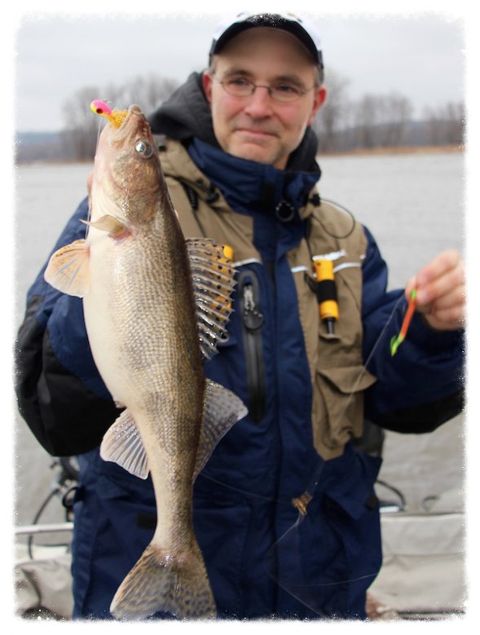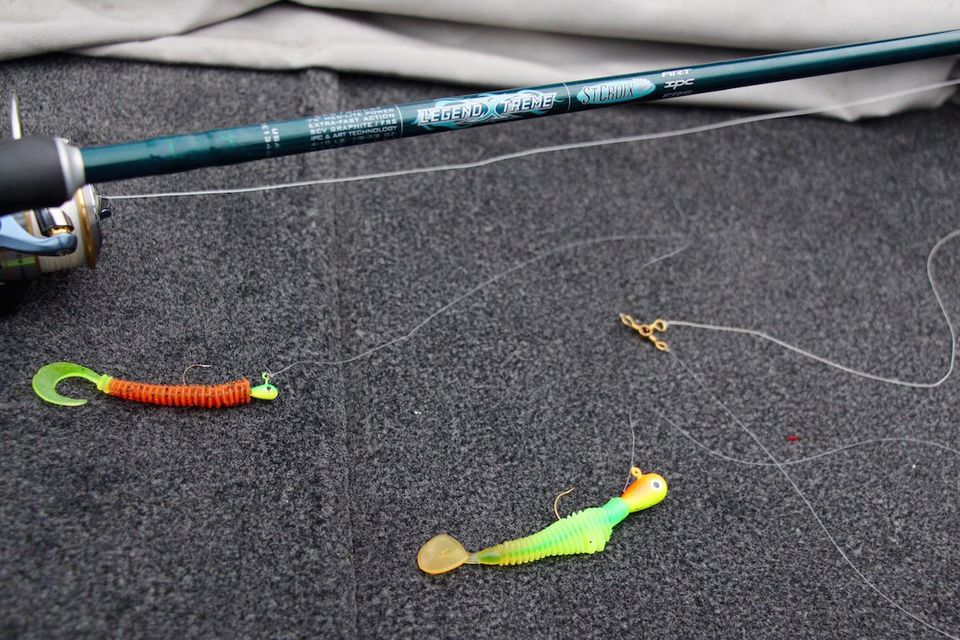Dubuque Rig Walleye Fishing

The Dubuque Rig for River Walleyes
River anglers are renowned for developing unique rigs to help them tackle their ever-changing, current-driven environment. Many of these rigs have unique names that refer to their developer, place of origin, or most useful application. One of my favorite rigs for early- and late-season walleye fishing, when the water is generally running high, fast and dirty, is the Dubuque Rig.
The Dubuque Rig is designed for trolling, generally upstream (although downstream is possible when flows are low), and is centered around the venerable 3-way swivel. Attach your main line to one of the swivel eyes. To a second and third eyes, attach mono leaders with two different lengths: a "short" leader that is about a foot in length, and a "long" leader that is 24-30" in length. We will use these mono leaders to connect two baits to the rig. I tie a heavy jig (1/2-3/4 oz) to the long leader, and dress that jig with a bulky soft plastic like a 4" ringworm or a Moxi from B-Fish-N tackle. I lie a light jig (1/16 oz) to the short leader, and dress that jig with a low-profile soft plastic like a shortened ringworm or a small fluke-style bait.
The Dubuque Rig is designed for trolling, generally upstream (although downstream is possible when flows are low), and is centered around the venerable 3-way swivel. Attach your main line to one of the swivel eyes. To a second and third eyes, attach mono leaders with two different lengths: a "short" leader that is about a foot in length, and a "long" leader that is 24-30" in length. We will use these mono leaders to connect two baits to the rig. I tie a heavy jig (1/2-3/4 oz) to the long leader, and dress that jig with a bulky soft plastic like a 4" ringworm or a Moxi from B-Fish-N tackle. I lie a light jig (1/16 oz) to the short leader, and dress that jig with a low-profile soft plastic like a shortened ringworm or a small fluke-style bait.


This rig is designed to be presented from a moving boat. Position your boat downstream of your intended fishing area, and start moving upstream at a speed of 0.5-0.8 mph. With the boat moving, lower the rig into the water, allowing the heavier jig to contact the bottom. Present the rig with a series of lifts and drops, releasing enough line to allow the heavy jig to remain in contact with the bottom during the drop. In high-flow areas, you will likely notice that most of your bites occur on the bottom jig, while the top bait, fluttering off the bottom, will be a key producer under low-flow conditions and in cleaner water.
The Dubuque Rig is quite versatile. Common modifications include using a much longer leader for the "upper" bait, and connecting that leader to a long-shank live bait hook dressed with a minnow. In some parts of the walleye belt, a trolling fly will take the place of the bare hook. Another variation is to attach a small floating Rapala crankbait to this elongated leader, allowing the heavy jig and the bottom of the rig to pull this crankbait down to depth. Likewise, some anglers will cast a Dubuque Rig to fish the front faces of wingdams from an anchored or Spot-Locked boat. Day in and day out, however, I use the Dubuque Rig as described above, with two jigs each dressed with a soft plastic, presented from a moving boat.
You'll be presenting relatively heavy baits in moving water, and as such, this is no place for a wimpy walleye rod. Two rods are particularly well-suited for presenting the Dubuque Rig. On the spinning side of the family, I like a St. Croix 6'8" MXF rod, which you can find in series ranging from the Eyecon all the way to the Legend Xtreme. I like the same length and action in the Avid X casting series; look for the AXC68MXF to find a rod that can pull double duty for chasing walleyes and summer bass. Spool up with 20 lb test braid, and you're ready to fish.
The Dubuque Rig is quite versatile. Common modifications include using a much longer leader for the "upper" bait, and connecting that leader to a long-shank live bait hook dressed with a minnow. In some parts of the walleye belt, a trolling fly will take the place of the bare hook. Another variation is to attach a small floating Rapala crankbait to this elongated leader, allowing the heavy jig and the bottom of the rig to pull this crankbait down to depth. Likewise, some anglers will cast a Dubuque Rig to fish the front faces of wingdams from an anchored or Spot-Locked boat. Day in and day out, however, I use the Dubuque Rig as described above, with two jigs each dressed with a soft plastic, presented from a moving boat.
You'll be presenting relatively heavy baits in moving water, and as such, this is no place for a wimpy walleye rod. Two rods are particularly well-suited for presenting the Dubuque Rig. On the spinning side of the family, I like a St. Croix 6'8" MXF rod, which you can find in series ranging from the Eyecon all the way to the Legend Xtreme. I like the same length and action in the Avid X casting series; look for the AXC68MXF to find a rod that can pull double duty for chasing walleyes and summer bass. Spool up with 20 lb test braid, and you're ready to fish.

Where should we present the Dubuque Rig? In the high flows of spring, focus on current seams near the shorelines. These will often be found in 6-10 feet of water, and will be a key location from the pre-spawn through the post-spawn period. When currents subside, or when fishing cold clear water in the late fall and winter, slip out toward the main channel and fish the channel edges, often in 18-25 feet of water. Focus on areas that are obviously holding fish. I rely on my Humminbird CHIRP 2D sonar
to help me find fish that are tucked tight to the bottom. The long sonar pulses, coupled with a wide range of transmitted sonar frequencies, provide for excellent target separation and size discrimination. Spending your fishing time in spots where the fish are!
In the high flows and dirty water of spring and fall, the Dubuque Rig is a proven river walleye producer. Tie one on the next time you head upstream!
In the high flows and dirty water of spring and fall, the Dubuque Rig is a proven river walleye producer. Tie one on the next time you head upstream!